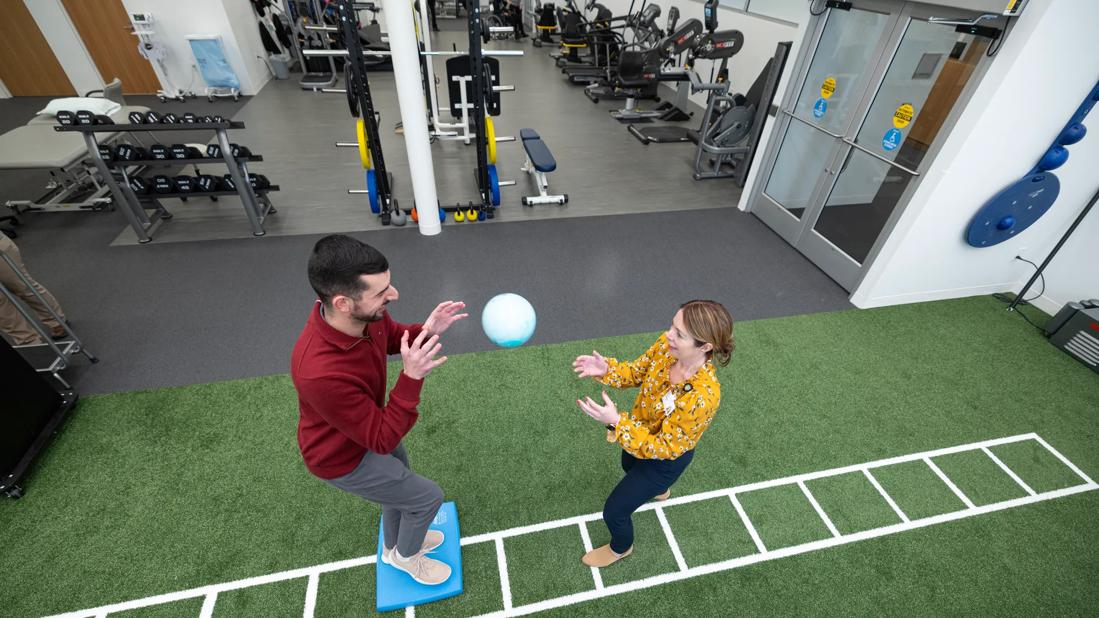Nonpharmacologic management improves QoL over 12 weeks

A novel rehabilitation program for chronic low back pain that combines physical therapy with cognitive behavioral therapy and pain neuroscience education effectively improves participants’ quality of life across multiple metrics. So reported Cleveland Clinic psychologist Sarah Rispinto, PhD, in a poster presentation at the 2018 annual meeting of the American Academy of Pain Medicine in May.
Advertisement
Cleveland Clinic is a non-profit academic medical center. Advertising on our site helps support our mission. We do not endorse non-Cleveland Clinic products or services. Policy
The program, known as Back on TREK, yielded clinically significant changes over a 12-week study period in measures of social role satisfaction, pain interference in daily life, perceived disability, fatigue and overall physical health. It also improved depression and anxiety in nearly half of participants.
Of the two-thirds of people who experience back pain at some point in their lives, many receive a highly medicalized regimen of medications, injections and sometimes surgeries before trying a nonpharmacological intervention like Back on TREK. “Many patients are a bit skeptical of our approach, but once they’re enrolled and engaged in the program, they tend to stay,” explains Dr. Rispinto, a staff member in Cleveland Clinic’s Center for Neurological Restoration. “They begin to understand that pain is a biopsychosocial phenomenon and they can learn ways to self-manage it.”
Back on TREK was launched at Cleveland Clinic in 2016 as an interdisciplinary effort to change the standard of care for chronic low back pain and reduce the risk of chronic disability. The 12-week program runs at three locations for psychology sessions and two locations for physical therapy, and is offered several times a week at varying times of day to accommodate patient schedules. Shared appointments with spine physicians and nurses are included to meet patients’ medical needs and develop individualized treatment plans.
“We’ve been surprised by the diversity of patients who join the program and have benefited from it,” Dr. Rispinto notes. “It ranges from people who are working full-time to those who’ve been disabled with chronic back pain for 30 years. We’ve found that Back on TREK is successful for most of them.”
Advertisement
To formally evaluate the benefits of the intervention, Dr. Rispinto and her Center for Neurological Restoration colleague Sara Davin, PsyD, MPH, retrospectively studied a cohort of 116 Back on TREK participants with chronic low back pain of greater than three months’ duration.
Patients were referred to the program by multiple sources, including Cleveland Clinic’s call center, spine specialists, primary care physicians and physical therapists (PTs). All were evaluated by both a pain psychologist and a PT before enrollment. Subjects with depression, anxiety or comorbid addiction were included in the study, but patients were excluded if they had medical red flags or had severe mental health instability that rendered them highly unlikely to benefit from the program. The patient population was 65 percent female, with a mean age of 50 years.
All patients were required to attend the program for three hours a week, including a mandatory 90-minute behavioral medicine group session consisting of education on pain neuroscience and chronic pain as well as cognitive behavioral therapy techniques related to improving coping skills, pacing activities and reducing pain catastrophizing. They also participated in group and individual physical therapy sessions.
The researchers found statistically significant changes from baseline to assessment at 12 weeks across all outcomes evaluated, including the Modified Oswestry Disability Index and the fatigue, functional status, global physical health, pain interference and social role functioning subscales of the PROMIS® (Patient-Reported Outcomes Measurement Information System) set of measures.
Advertisement
“Almost half of participants also had clinically significant changes in measures of depression and anxiety,” adds Dr. Rispinto. The outcomes of Back on TREK are being expanded to compare the program’s effectiveness to standard physical therapy, and that study is currently under review, she notes.
Back on TREK is currently supported by Cleveland Clinic’s Neurological Institute, with group sessions provided to patients at no charge. “We hope to raise the profile of biopsychosocial approaches like Back on TREK as a first-line intervention for chronic back pain,” Dr. Rispinto explains.
She says that ongoing research projects include looking at whether Back on TREK reduces opioid use and healthcare utilization over the long term, as well as characterizing participants who continue with the program versus those who drop out.
The Back on TREK team also hopes to compare outcomes between patients who participated in the program and those who did not, as well as to eventually develop similar programs to manage other chronic pain conditions, such as fibromyalgia and migraine.
Advertisement
Advertisement

Dopamine agonist performs in patients with early stage and advanced disease

Validated scale provides a method for understanding how lifestyle may protect against Alzheimer's

Promising preclinical research indicates functional motor recovery is durable

A principal investigator of the landmark longitudinal study shares interesting observations to date

Cleveland Clinic researchers collaborate with Microsoft to create a product ready for the field

Understanding TE involvement is a key to developing new treatments

Study aims to inform an enhanced approach to exercise as medicine

$3.2 million grant will fund use of calcium-based imaging to record neuronal activity in ischemia model